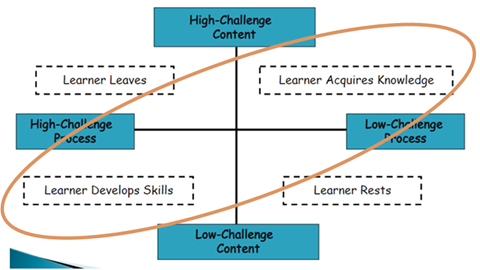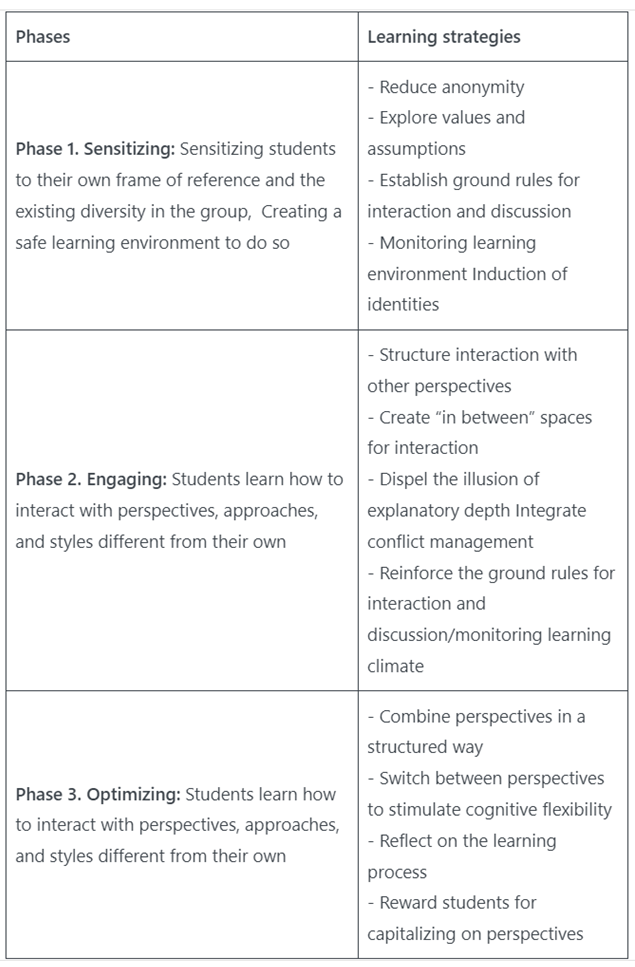Including different perspectives

“Often we have group discussions about topics with the whole group or are even asked to do so in the lecture hall but I find it quite nerve-wracking to have to speak up like that and when I am nervous I blank. I hate it when my name is called and my mind just freezes. I like to have some time before I have to talk in front of the class. I know others feel the same way and now it is just a handful of people that are always speaking in class.”
In education, it can be difficult to include the wide variety of different viewpoints and perspectives there might be on a topic. Making new ideas meaningful and acknowledging students prior knowledge can promote deeper learning. To achieve this, students need to be open to explore perspectives different from their own, as differences might lead to moments of tension which may influence the learning process negatively Caroll, J. N. (2015). Tools for Teaching in an Educationally Mobile World. Journal of Interactive Media in Education, 10, pp. 1–2, http://dx.doi. org/10.5334/jime.au . There are two general ways in which different viewpoints and perspectives can be included in your course or program:
- stimulating (all) students to share their opinions, and
- exposing students to different perspectives from others outside the course.
The first can be quite difficult as it requires the active participation of all students and they have to feel comfortable enough to speak up. For the latter, a scarcity of resources may cause issues. Moreover, creating an atmosphere where students can bring their own identities and differences in the classroom safely is crucial when stimulating an inclusive learning environment Ramdas, S., Slootman, M., & Van Oudenhoven-Van der Zee (2019). The VU mixed classroom model. .
Tools
Including different perspectives
VU Mixed Classroom model
For students to share their perspectives, teachers need to ensure that the learning environment is safe and inclusive. Ramdas and colleagues (2019) Ramdas, S., Slootman, M., & Van Oudenhoven-Van der Zee (2019). The VU mixed classroom model. describes some strategies:
- Acknowledging approaches and perspectives (e.g., “That is an interesting point”, instead of “that is not relevant at the moment”)
- Welcoming approaches and perspectives (e.g., by elaborating on the student’s input)
- Offering approaches and perspectives (e.g., including literature of authors with minority identities, or challenging a majority opinion).
- Actively inviting approaches and perspectives (e.g., activities that stimulate students to bring in diverse perspectives or explore those of other students)
- Combining approaches and perspectives (e.g., demonstrate how combining different perspectives in the classroom can lead to a new perspective)
For a more detailed description about these and other strategies, see Ramdas, Slootman, and Oudenhoven-van der Zee (2019). VU Mixed Classroom model (Mixed_Classroom_booklet_tcm270-935874.pdf (vu.nl)
Balancing the challenge of process and content
Bennett’s model helps teachers to ensure that students from different backgrounds and with different viewpoints are heard in group discussions and to ensure that all students can actively participate in class. When selecting teaching and learning activities, the model emphasises the need for a balance between content and process.
Bennett’s model, shown below, can be useful for understanding how a teacher can balance the challenge presented by the content students need to study and the challenge presented by the activities students need to carry out
Bennett, J.M. (1999). Cultural marginality: identity issues in intercultural training. In R.M. Paige (Ed), Education for the Intercultural Experience. (2nd ed., pp. 109-135). Yarmouth, ME: Intercultural Press.New Yor: Atherton Press.
Sanford, N., (1966). Self and society: Social change and individual development. New Yor: Atherton Press
.

There are two axes in the model. On the content axis, you find on one side high-challenge content, such as discussions about sexual orientation, power, or race. At the other end you find low-challenge content, which might include widely agreed or non-contested content such as the order in which historical events happened. On the other axis, you find TLAs that involve challenging processes (such as role play and simulations) and TLAs that are not so challenging for students, such as lectures, videos, or reading.
Examples of teaching activities to be discussed in the classroom (from lower to higher challenge): Lecture, video, reading, critical incident (brief description by students about important events in their lives), case study (learning from analyzing examples), fish bowl (a form of dialogue – in which a number of chairs are arranged as a circle; in which the teacher introduces the topic and the students start discussing it), role-play (students are placed in the position of relevant decision makers, forcing them to apply the content to determine a policy or solve a problem).
If you want students to acquire knowledge, it is good to have high -challenge content, but to keep low processing demands. If you want students to acquire skills such as intercultural competences, it is advisable to use high process TLAs coupled with less challenging content. Teachers can first assess the challenge in the content area for the specific group of students and balance this challenge level by selecting TLAs that do not exceed that challenge. In this way, they can endeavour to promote students’ learning processes.
Facilitating classroom discussions in a safe learning environment
Discussions are commonly used to engage students, however, they could exclude certain students if not well-designed. Below, you will find strategies to help design and support discussions in a safe and inclusive learning environment.
Establishing discussion rules
Firstly, it is important to establish the ground rules for dialogue, interaction, and behavior at the beginning of each course. These rules help to create a safe space for interaction and ensure that everyone is aware of the behaviour expected. Agreeing the ground rules for dialogue with the class can help to promote ‘buy-in’ and voluntary compliance. Treviño has proposed some guidelines for teachers on how to facilitate classroom discussions while creating a safe learning environment Treviño, J. (n.d.). Diversity and Inclusiveness in the Classroom. The University of Arizona. .
- Explain why conversations about diversity are important. We share the responsibility to be engaged in dialogue about oppression, bias, power, and other topics related to living in a multicultural world.
- Explain that sharing is voluntary, meaning that students can share their perspectives and experiences to the degree that they are comfortable.
- Students should not be expected to speak on behalf of or represent an entire race, culture, gender, etc.
- Explain that students’ views may vary, and that the most important part of intergroup dialogue is creating a space for the exchange of different feelings, thoughts, and beliefs.
- Explain that students should avoid quick judgments.
- Encourage students to practice active listening and to give full attention to whomever is talking.
- Encourage the acknowledgement of emotions and feelings. We may laugh and cry together, share pain, joy, fear and anger.
- Explain that in dialogues, everybody may make mistakes. What is most important is that we use these moments as occasions for learning and forgiving
Inclusive and equitable discussions
Stanford University has created a list of strategies that teachers can use to make classroom discussions more inclusive and ensure that all students (e.g., including students who are quiet and/or who are not actively participating because of their minority identity in group discussions/interactions) are able to participate:
- Support students when examining potentially sensitive/upsetting content (ie sexual harassment) and use trigger warnings
- Use prompts or questions that elicit a variety of perspectives
- Ensure equitable participation in the discussion (e.g., by assigning roles to students)
- Randomly assign or select students with an equitable prompt (e.g., by selecting the student whose birthday is the soonest)
- Be considerate about putting students on the spot (e.g., by informing students at the beginning of the course that this will happen, and inquiring privately whether students do not want to share their experience)
- Be flexible about participation
- Evaluate discussions along various dimensions
For more information, see Inclusive and Equitable Discussions | Teaching Commons (stanford.edu)
Facilitating discussion in the (international) classroom
In their article, Crose (2011) Crose, B. (2011). Internationalization of the Higher Education Classroom: Strategies to Facilitate Intercultural Learning and Academic Success. International Journal of Teaching and Learning in Higher Education. Volume 23, Number 3, 388-395 lists some useful activities that teachers can employ to facilitate safe discussions in the classroom:
- Provide students with the discussion topics in advance, so they can prepare for classroom discussions and formulate some of their responses in advance. This will also decrease students’ anxiety and increase their participation Arkoudis, K. (2006). Teaching international students: Strategies to enhance learning. Crose, B. (2011). Internationalization of the Higher Education Classroom: Strategies to Facilitate Intercultural Learning and Academic Success. International Journal of Teaching and Learning in Higher Education. Volume 23, Number 3, 388-395 .
- Pair students to practice responses to discussion questions Crose, B. (2011). Internationalization of the Higher Education Classroom: Strategies to Facilitate Intercultural Learning and Academic Success. International Journal of Teaching and Learning in Higher Education. Volume 23, Number 3, 388-395 . Furthermore, pair an international student with a local one. These conversations with peers allow international students to practice their language skills in a non-threatening environment while also receiving feedback on their understanding of the discussion topic, so they feel more comfortable in the subsequent group discussion setting Rose-Redwood, C. R. (2010). The challenge of fostering cross-cultural interactions: A case study of international graduate students' perceptions of diversity initiatives. College Student Journal, 44(2), 389–399. .
Source and more information about these strategies: Microsoft Word – Classroom Dialogue Guide Revised[2].docx (arizona.edu)
Facilitating classroom discussions among quiet students
Some students are uncomfortable participating in classroom discussions, for example due to their personalities (e.g., introverted students) or cultural or socio-economic backgrounds. GoGuardian.com has collected some strategies to involve these so-called ‘quiet students’ GoGuardian (2019). How to Engage Quiet Students in the Classroom. .It is important to involve such students in classroom activities as much as possible, as they help students engage actively with the subject matter and promote their success within the course. Some strategies to engage quiet students are below:
1. Break away from whole group discussions
- Stand and Talk: Students walk around the room and find a partner to talk to about the assignment
- Four Corners: When each corner of the classroom represents a choice, answer or statement, students can walk to the corner that represent their choice. This allow students to participate even if they are reluctant to be vocal about their ideas. See for more info: ttp://www.eworkshop.on.ca/edu/pdf/Mod36_coop_four_corners.pdf
- Think, Pair, Share: This is an activity that asks students to consider a question individually (think), discuss their ideas with another student (pair), and share their joint ideas in a plenary discussion (share). This activity lowers barriers to participation, because students can take time to think for themselves and share their ideas with peers before sharing the with the whole class (see the CAT-database for more examples).
2. Offer alternatives for discussions and presentations by, for example, starting an online discussion instead of a classroom discussion.
3. Assign roles to change the dynamic of group work
Some roles to assign to student participants are:
- Facilitator: Leads the activity; makes sure everyone understands the task; and keeps the group focused so the work gets done.
- Resource monitor: Collects and monitors supplies for the group; supervises cleanup.
- Reporter: Ensures that everyone in the group is completing written work; supervises any group report or write-up.
- Presenter: Uses the reporter’s notes to present the group’s findings to the class.
4. Have private one-on-one conversations with students to check if they have concerns and find out if/why they are reluctant to participate.
Source and more information about these strategies: Source: How to Engage Quiet Students in the Classroom (goguardian.com)
Activities to promote a safe and diverse larning environment
As Ramdas and colleagues (2019) argue, while most teachers agree on the importance of being open to other perspectives, in practice, creating an atmosphere where students and teachers can bring their own identities into the classroom can be a challenge Ramdas, S., Slootman, M., & Van Oudenhoven-Van der Zee (2019). The VU mixed classroom model. . The VU Mixed Classroom Educational Model is built on a three-phase process through which students learn how to capitalize on different perspectives and approaches. Three phases are distinguished: Sensitizing, Engaging, and Optimizing (see Table below Dowload word version). In this model, having an inclusive learning environment is a precondition for creating an optimal space where differences can be discussed in safe ways.

For a more detailed description about these strategies, see for example section 1.2.4 (Facilitating classroom discussions for quiet students) and section 3 (collaborative learning) and Ramdas, Slootman, and Oudenhoven-van der Zee (2019). VU Mixed Classroom model (Mixed_Classroom_booklet_tcm270-935874.pdf (vu.nl).
